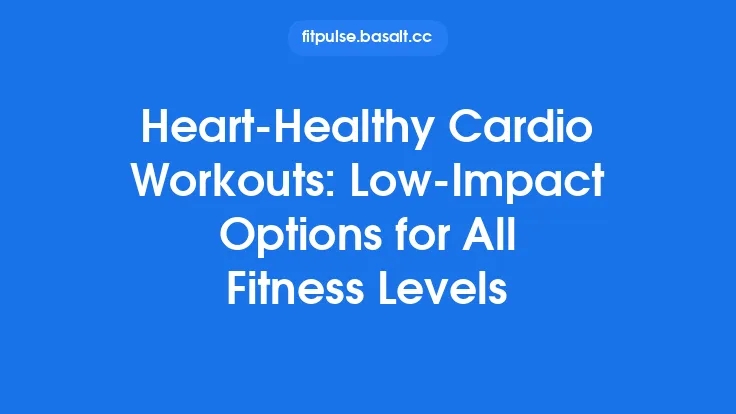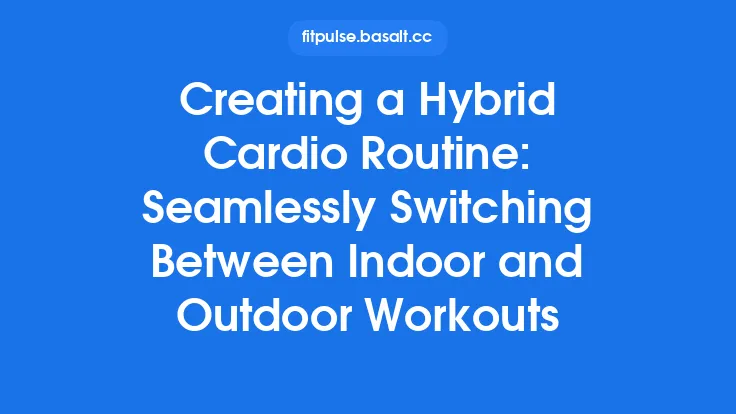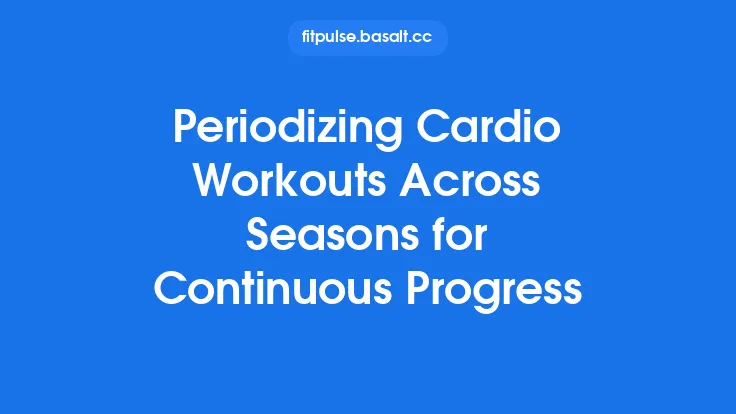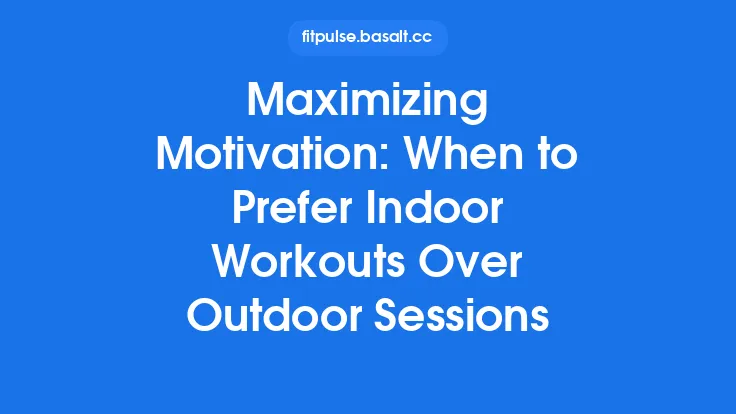Indoor cycling has become a staple in gyms, boutique studios, and home workout spaces because it delivers a high‑intensity cardiovascular stimulus while being low‑impact on the joints. The controlled environment of a stationary bike allows you to manipulate resistance, cadence, and interval timing with precision, making it an ideal platform for structured cardio sessions that can be tailored to any fitness level. Below is a comprehensive guide to designing, executing, and progressing indoor‑cycling workouts that maximize cardiovascular benefits while keeping the sessions engaging and sustainable.
Understanding the Core Variables
| Variable | What It Controls | Typical Range for Indoor Cycling |
|---|---|---|
| Resistance | The mechanical load applied to the flywheel or magnetic system. Higher resistance mimics climbing; lower resistance simulates flat terrain. | 1–20 (on most bike consoles) or 0–100 % of the bike’s maximum resistance. |
| Cadence | Pedal revolutions per minute (RPM). Faster cadence emphasizes speed; slower cadence emphasizes strength. | 60–120 RPM; beginners often stay 70–85 RPM, while advanced riders may sustain 100+ RPM in intervals. |
| Duration | Total time of the workout, influencing total caloric expenditure and aerobic adaptation. | 20 min (quick HIIT) to 90 min (endurance rides). |
| Interval Structure | The pattern of work and rest periods, shaping the stimulus on the cardiovascular system. | 30 s–5 min work intervals, with equal or shorter rest periods. |
| Heart‑Rate / Power Zones | Objective intensity markers that help keep effort within desired training zones. | HR zones 1–5 (or 50‑90 % of max HR); Power zones 1–7 (or 50‑100 % of FTP). |
By manipulating these variables, you can craft workouts that target specific cardio adaptations—whether it’s improving aerobic base, boosting VO₂ max, or sharpening anaerobic capacity.
The Anatomy of a Structured Session
A well‑balanced indoor‑cycling class or solo ride typically follows a three‑phase template:
- Warm‑Up (5‑10 min)
- Begin with low resistance and moderate cadence (80‑90 RPM).
- Gradually increase resistance every 2 minutes to raise core temperature and prime the cardiovascular system.
- Include a brief surge (30 seconds at 90‑100 RPM) to activate fast‑twitch fibers.
- Main Set (15‑60 min)
- This is the heart of the workout, where the chosen interval or steady‑state format is executed.
- The main set can be broken into multiple blocks (e.g., two 20‑minute pyramids) to provide mental variety.
- Use heart‑rate or power feedback to stay within the target zone.
- Cool‑Down (5‑10 min)
- Reduce resistance to a comfortable level and pedal at a relaxed cadence (70‑80 RPM).
- Allow heart rate to descend gradually; this aids in metabolic waste removal and promotes recovery.
Core Workout Formats
1. Steady‑State Endurance Ride
- Goal: Build aerobic capacity and improve fat‑oxidation efficiency.
- Structure: 45‑60 min at a constant moderate intensity (Zone 2, ~65‑75 % of max HR).
- Key Points: Keep cadence steady (80‑90 RPM) and resistance low enough to sustain the effort without excessive fatigue.
2. Classic Interval Training (HIIT)
- Goal: Elevate VO₂ max and increase calorie burn post‑exercise (EPOC).
- Structure: 30 seconds of high intensity (Zone 4‑5, 85‑95 % max HR) followed by 60 seconds of active recovery (Zone 1‑2). Repeat 10‑12 times.
- Key Points: Push cadence above 100 RPM during work intervals; keep resistance challenging but manageable for the short burst.
3. Pyramid Intervals
- Goal: Blend endurance and power, providing a progressive overload within a single session.
- Structure:
- 1 min work / 1 min recovery
- 2 min work / 2 min recovery
- 3 min work / 3 min recovery
- 4 min work / 4 min recovery
- Then descend back down (3‑2‑1).
- Key Points: Increase resistance with each step up the pyramid; maintain a cadence of 85‑95 RPM.
4. Tabata‑Style Sprint Sets
- Goal: Maximize anaerobic power and improve sprint capacity.
- Structure: 20 seconds all‑out effort (Zone 5, >95 % max HR) followed by 10 seconds rest; repeat 8 rounds (4 min total).
- Key Points: Use a high gear to generate torque; keep cadence low (60‑70 RPM) to focus on force production.
5. Power‑Zone Training (FTP‑Based)
- Goal: Provide a data‑driven approach for cyclists who track functional threshold power (FTP).
- Structure:
- Warm‑up: 10 min (Zone 1‑2).
- Main set: 2 × 20 min at 95‑105 % of FTP (Zone 4) with 5 min recovery between blocks.
- Cool‑down: 10 min (Zone 1).
- Key Points: Requires a power meter; ideal for athletes seeking precise performance metrics.
Sample Weekly Plans
Beginner (3 sessions/week)
| Day | Session | Focus |
|---|---|---|
| Mon | 30‑min Steady‑State (Zone 2) | Build aerobic base |
| Wed | 20‑min HIIT (30 s/60 s) | Boost cardio capacity |
| Fri | 35‑min Pyramid (1‑2‑3‑2‑1) | Mix endurance & power |
Progression: Add 5 minutes to the steady‑state ride each week, or increase the work interval by 5 seconds after two weeks.
Intermediate (4 sessions/week)
| Day | Session | Focus |
|---|---|---|
| Mon | 45‑min Endurance (Zone 2) | Aerobic endurance |
| Tue | 30‑min Power‑Zone (FTP) | Threshold work |
| Thu | 25‑min Tabata + 10‑min recovery | Anaerobic power |
| Sat | 60‑min Mixed Pyramid (1‑2‑3‑4‑3‑2‑1) | Comprehensive stimulus |
Progression: Increase FTP‑based intervals by 2‑3 minutes every 3 weeks, or add a second set of Tabata on Thursday after a month.
Advanced (5‑6 sessions/week)
| Day | Session | Focus |
|---|---|---|
| Mon | 60‑min Endurance (Zone 2‑3) | Base mileage |
| Tue | 40‑min Power‑Zone (2 × 20 min @ 100 % FTP) | Threshold |
| Wed | 30‑min HIIT (45 s/45 s) + 10‑min sprint finish | VO₂ max |
| Thu | 45‑min Mixed Pyramid (2‑3‑4‑5‑4‑3‑2) | Strength & stamina |
| Fri | 20‑min Tabata + 15‑min active recovery | Sprint power |
| Sun | Optional 30‑min Recovery Ride (Zone 1) | Active recovery |
Progression: Every 4‑6 weeks, replace one endurance ride with a “long‑zone” ride (Zone 3‑4 for 45 minutes) to stimulate higher lactate tolerance.
Monitoring Intensity Without Fancy Tech
Not everyone has a heart‑rate monitor or power meter, but you can still gauge effort reliably:
- Talk Test: In Zone 2 you can hold a conversation; in Zone 4 you can speak only a few words.
- Perceived Exertion (RPE): Use a 1‑10 scale; aim for 4‑5 during steady rides, 7‑8 during work intervals.
- Cadence Feel: A smooth, rapid pedal stroke (90‑110 RPM) usually indicates lower resistance; a slower, more forceful turn (60‑80 RPM) signals higher load.
Safety and Injury Prevention
Even though indoor cycling is low‑impact, certain precautions keep the experience safe:
- Seat Height: When seated, your leg should have a slight bend at the bottom of the pedal stroke. This reduces knee strain.
- Handlebar Reach: Keep elbows slightly bent; excessive forward lean can stress the lower back.
- Hydration: Keep a water bottle within reach; even moderate sessions can cause significant sweat loss.
- Progressive Load: Increase resistance or interval length by no more than 10 % per week to avoid overuse injuries.
- Listen to Your Body: Sharp pain, especially in the knees or lower back, warrants an immediate reduction in intensity or a rest day.
Adapting Workouts for Different Goals
| Goal | Recommended Session Types | Frequency |
|---|---|---|
| Weight Management | HIIT, Tabata, Short‑Duration High‑Intensity Intervals | 3‑4 × week |
| Endurance Racing (e.g., Gran Fondo) | Long Steady‑State, Mixed Pyramid, Power‑Zone Threshold | 4‑5 × week |
| Sprint Performance | Tabata, Short Sprints, High‑Resistance Low‑Cadence Intervals | 2‑3 × week |
| General Cardiovascular Health | Balanced mix of steady rides and moderate intervals | 3 × week |
Frequently Asked Questions
Q: How long should a beginner stay in Zone 2 before moving to intervals?
A: Most beginners benefit from 4‑6 weeks of consistent Zone 2 riding to develop a solid aerobic foundation. After this period, introduce a single 10‑minute interval block per session and gradually increase its length.
Q: Is it necessary to use a fan or ventilation during intense rides?
A: Yes. High‑intensity indoor cycling can raise core temperature quickly. A fan, open window, or air‑conditioned space helps maintain comfort and prevents overheating.
Q: Can I combine strength training with indoor cycling on the same day?
A: Absolutely, but schedule them strategically. If you perform a heavy leg‑focused strength session, place the cycling workout later in the day or keep it low‑intensity to avoid overtaxing the same muscle groups.
Q: How do I know if I’m overtraining?
A: Persistent fatigue, declining performance, elevated resting heart rate, and disturbed sleep are common signs. Incorporate at least one full rest day per week and consider a “deload” week (reduce volume by 30‑40 %) every 4‑6 weeks.
Building a Sustainable Indoor‑Cycling Habit
- Set Clear, Measurable Goals – Whether it’s “ride 150 minutes per week” or “complete a 30‑minute HIIT session without dropping cadence,” specific targets keep motivation high.
- Use a Calendar – Block workout times just as you would a meeting; consistency beats occasional marathon sessions.
- Track Progress – Simple logs of duration, perceived effort, and how you felt post‑session reveal trends and guide adjustments.
- Mix It Up – Rotate between the workout formats outlined above to prevent mental boredom and stimulate different physiological pathways.
- Celebrate Milestones – After completing a 6‑week block, treat yourself to a new playlist, a bike accessory, or a recovery massage.
Final Thoughts
Indoor cycling offers a uniquely controllable environment for cardiovascular conditioning. By understanding the core variables—resistance, cadence, duration, and interval structure—you can design workouts that precisely target aerobic endurance, VO₂ max, or anaerobic power. Structured sessions that follow a warm‑up, main set, and cool‑down framework ensure safety and maximize training efficiency. Whether you’re a beginner seeking a solid aerobic base or an advanced athlete fine‑tuning threshold power, the formats and sample plans provided here can be adapted to fit any schedule, equipment level, or performance goal. Consistency, progressive overload, and attentive monitoring of effort will keep you on the path to lasting cardio fitness—right from the comfort of your indoor bike.





